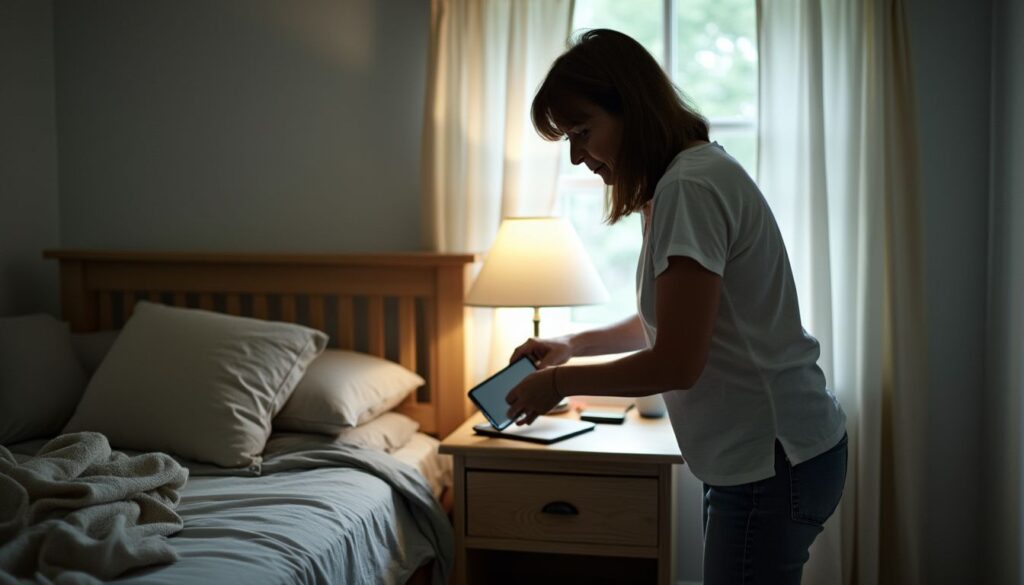Finding the right bedroom furniture for caregivers is tough. Good news—research shows family involvement aids recovery. This blog will guide you to top bed options and more for ease of use, ensuring comfort for both patient and caregiver.
Read on for insights!
Key Takeaways
- Adjustable beds and smart alarms keep patients safe. They stop them from falling.
- Comfortable chairs like the Amari Recliner help caregivers rest. This is good for their backs.
- Fold-up wall beds save space in small rooms. Caregivers can use more room during the day.
- Noise-cancelling tools help caregivers sleep well. Quiet helps them feel better.
- Furniture that is easy to use makes caregiving less hard. It helps caregivers do a better job.
Evaluating the Best Bedroom Furniture for Caregivers

Choosing the right bedroom furniture for caregivers is all about comfort and how easy it is to use. We look at beds, chairs, and other items to find what works best in care settings.
Comfort and Ergonomics
Caregivers need chairs that don’t hurt their back. The Amari Recliner has a seat and back shaped to fit the body well, with different ways to lean back and relax. This chair helps caregivers rest during long shifts.
Some chairs move to help people feel less nervous. Hale motion chairs let caretakers shift easily, keeping them comfy while sitting for a long time. These pieces make sure caregivers can move without pain or stress.
Ease of Use and Functionality
After talking about comfort, let’s focus on ease of use and how things work. Furniture for caregivers must be simple to handle. It means beds, chairs, and other items must work well without trouble.
They should help caregivers do their jobs better.
For example, the Accord™ recliner comes with SafeBrake and IntelliTrac™ casters. These make it safe and easy to move around. The sleepToo® Sleep Sofa fits many needs—eating, sleeping, working—in just 20 square feet.
Then there’s the Perk + SmartRail® that offers strong seats and smart storage spaces. All these pieces are made thinking about care workers’ everyday tasks.
Easy-to-use furniture makes caregiving less stressful.
Top Pick: Adjustable Caregiver Beds
Adjustable beds for caregivers top our list. They adjust easily, making work easier and rest better for those helping others.
Features & Benefits
Adjustable caregiver beds make life easier. They help both the caregiver and the person they care for.
- Accord™ recliner’s SafeBrake system stops the chair from moving unexpectedly. This makes it safer for everyone.
- IntelliTrac™ wheels move smoothly. Caregivers can push the chair easily.
- Allay® Sleep Sofa has a handle that lets it change into a bed fast. This saves time at night.
- Amari Recliner is good for the planet and comfortable to sit in. Caregivers can relax between tasks.
These features show how much thought goes into making furniture that supports caregivers’ work. From chairs that stop on their own to sofas that turn into beds quickly, each piece has something special to offer. Safety brakes, easy movement, quick changes, and comfort are key. They make sure caregivers can do their best without extra stress.
Pros & Cons
Choosing the right bedroom furniture is key for caregivers. It needs to be safe, easy to use, and comfortable. Here are some pros and cons of different options:
- Adjustable Caregiver Beds
- Pros:
- SafeBrake and IntelliTrac casters make moving the bed easy while keeping it secure.
- Supports many activities in a small area, perfect for tight spaces.
- Cons:
- These beds can be costly because of their advanced features.
- Pros:
- Smart Caregiver Bed and Chair Exit Alarm System
- Pros:
- Alerts caregivers when a person tries to get up, enhancing safety.
- Easy to set up with devices like Amazon Echo for voice-activated convenience.
- Cons:
- Some users find setting up the system tricky without help.
- Pros:
- Healthcare Worker Lounge Chairs
- Pros:
- Very comfortable, which helps caregivers relax during breaks.
- Durable design lasts a long time.
- Cons:
- Large size might not fit in smaller rooms or apartments.
- Pros:
- Fold-Up Wall Beds
- Pros:
- Save space by folding up against the wall when not in use.
- Quick to set down for sleeping or resting.
- Cons:
- Limited styles available can make finding the right one hard.
- Higher price tags due to complex design.
- Pros:
- Noise-Cancelling Options for Caregiver’s Bedroom
- Pros:
- Block out noise, letting caregivers sleep better.
- Many products like earmuffs or white noise machines are easy to find online on sites like Amazon.com.
- Cons:
- Quality models can be expensive.
- Might not block out all types of noise.
- Pros:
Next, let’s look at what customers say about these products…
Best for Safety: Smart Caregiver Bed and Chair Exit Alarm System
The Smart Caregiver Bed and Chair Exit Alarm System is a key tool for safety. It alerts you when someone tries to get up. This system can prevent falls. Falls are a big worry in settings like nursing homes or for live-in caregivers.
The alarms work with both beds and chairs, making them flexible.
Safety features play a huge role here. For example, the SafeBrake in Accord recliner stops unwanted movement. IntelliTrac casters make moving safer by cutting down on fall risks. Also, Perk + SmartRail helps people sit safely and offers handy storage.
Keeping patients safe means staying one step ahead of falls – this system does just that.
Most Comfortable: Healthcare Worker Lounge Chairs
Moving from safety to comfort, healthcare worker lounge chairs stand out. The Accord™ recliner has a shaped seat and back. This makes it very comfy. Another chair, the Amari Recliner, lets people choose how they want to recline for the best rest.
Then there’s the Hale Collection with sturdy patient and motion chairs. These are good in places where healing happens because they make sitting nice and easy.
The sleepToo® Sleep Sofa is another great piece of furniture for caregivers. It gives them a cozy spot to rest close to those they care for. All these options make sure caregivers can relax well during their breaks or while staying nearby overnight.
Comfort leads to better care for both caregivers and those they help.
Space Efficiency: Fold-Up Wall Beds
Fold-up wall beds save a lot of space. They are perfect for small rooms. During the day, you can fold them up against the wall. This makes more space for other activities. At night, you pull the bed down to sleep on it.
Caregivers find these beds very useful in homes where space is tight.
Next, we explore noise-cancelling options that can help caregivers get better rest.
Enhancing the Caregiver’s Rest: Noise-Cancelling Options for the Caregiver’s Bedroom
Caregivers need quiet sleep. Noise-cancelling curtains and sound machines help. Curtains block outside noise. Machines create calming sounds. Both improve rest in a caregiver’s bedroom.
These options fit different needs and budgets. Soundproof windows are another choice but cost more. Each helps caregivers wake up refreshed, ready to care for others.
Customer and Caregiver Testimonials
Real people share their stories. They talk about how bedroom furniture changes the game for caregivers and those they care for.
Highlights from Positive Feedback
Caregivers face tough challenges every day. Positive feedback from users shows appreciation for products that help.
- Caregivers love the sleepToo® Sleep Sofa for its comfort. Many say it makes overnight stays less tiring.
- The Accord™ recliner gets praise for helping caregivers relax during breaks. Users appreciate its ergonomic design.
- Families mention Family Resource Home Care‘s great service often. They say it offers high-quality, compassionate care.
- Many find the adjustable caregiver beds a game-changer. They like how easy these beds make caring for loved ones.
- The Smart Caregiver Bed and Chair Exit Alarm System is a hit for safety reasons. Caregivers feel more at ease knowing their patients can’t get up unnoticed.
- Healthcare worker lounge chairs are also popular for their comfort level. Staff in longterm care facilities recommend them highly.
- For saving space, fold-up wall beds are liked by many families and live-in caregivers alike.
- Testimonials show that using noise-canceling options in the caregiver’s bedroom boosts rest quality significantly.
- Customers often use FSAs (Flexible Spending Accounts) and HSAs (Health Savings Accounts) to buy these products, noting it helps manage costs better.
Users highlight how these pieces of furniture and systems improve their ability to provide care effectively while also taking care of themselves.
Addressing Common Concerns
Hiring a caregiver involves important legal and safety steps. Filing taxes and checking qualifications are key.
- Background checks are crucial to ensure caregivers have no criminal history. This helps in securing trust.
- Licensing shows a caregiver has the needed skills for elder care or dementia patients.
- Bonding protects against theft, giving peace of mind to families.
- Insurance covers accidents, keeping both the caregiver and employer safe from unexpected costs.
- Taxes for live-in caregivers must be filed to avoid legal issues with income taxes and unemployment compensation.
- Legal concerns like potential lawsuits require clear terms of use in contracts.
- Home insurance might need an update to cover a live-in caregiver, ensuring protection against liability.
- Safety equipment like smart caregiver bed and chair exit alarm systems help prevent falls, a common concern in assisted living facilities.
- For those using wheelchairs or walkers, making sure the home is accessible with ramps or stair lifts is key.
- Families should talk about payment options upfront, including using credit cards or amazon prime for purchases related to caregiving.
Each step makes hiring and having a caregiver smoother for everyone involved.
Conclusion
Choosing the right furniture makes caregiving easier. Our reviews show that adjustable beds, smart alarms, and cozy chairs help a lot. They make rooms safer and more comfortable for everyone.
Also, saving space is key in small areas. Good choices lead to better rest for caregivers and those they care for. Our tips aim to guide you well in picking what works best.
FAQs
1. What bedroom furniture is best for a live-in caregiver?
The best bedroom furniture for a live-in caregiver depends on the needs of the cared individual, whether they’re in an assisted living facility or at home. It should promote healing environments and ensure easy housekeeping.
2. Does consumer protection apply when buying bedroom furniture online?
Yes, consumer protection applies to all online purchases including e-sign checkout for bedroom furniture. Always check the privacy policy before purchasing.
3. How does minimum-wage laws affect caregivers’ ability to furnish their rooms?
Minimum wage laws like nanny tax can impact a caregiver’s budget for furnishing their room in care homes or private residences, so it’s important to consider cost-effective options.
4. Are there any specific features that assist with family-centered care in bedroom furniture?
Yes! Features such as illumination control can greatly help caregivers during night-shifts without disturbing the grandparent or patient they are caring for.
5. Can I find reviews of bedroom furniture suitable for caregivers on Prime Video or Kindle?
While Prime Video and Kindle primarily offer entertainment content, you may find some related documentaries or eBooks discussing elements of caregiving which could include tips about selecting appropriate bedroom furniture.









